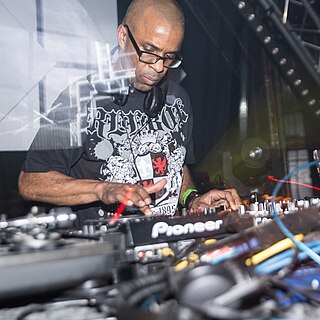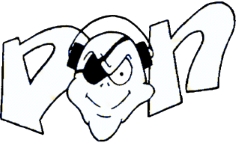Related Research Articles

Drum and bass is a genre of electronic dance music characterised by fast breakbeats with heavy bass and sub-bass lines, samples, and synthesizers. The genre grew out of the UK's jungle scene in the 1990s.
Breakbeat hardcore is a music genre that spawned from the UK rave scene during the early 1990s. It combines four-on-the-floor rhythms with breakbeats usually sampled from hip hop. In addition to the inclusion of breakbeats, the genre also features shuffled drum machine patterns, hoover, and other noises originating from new beat and Belgian techno, sounds from acid house and bleep techno, and often upbeat house piano riffs and vocals.

A rave is a dance party at a warehouse, club, or other public or private venue, typically featuring performances by DJs playing electronic dance music. The style is most associated with the early 1990s dance music scene when DJs played at illegal events in musical styles dominated by electronic dance music from a wide range of sub-genres, including drum and bass, dubstep, trap, break, happy hardcore, trance, techno, hardcore, house, and alternative dance. Occasionally live musicians have been known to perform at raves, in addition to other types of performance artists such as go-go dancers and fire dancers. The music is amplified with a large, powerful sound reinforcement system, typically with large subwoofers to produce a deep bass sound. The music is often accompanied by laser light shows, projected coloured images, visual effects and fog machines.
Breakbeat is a broad type of electronic music that uses drum breaks, often sampled from early recordings of funk, jazz, and R&B. Breakbeats have been used in styles such as Florida breaks, hip hop, jungle, drum and bass, big beat, breakbeat hardcore, and UK garage styles.
Jungle is a genre of electronic music that developed out of the UK rave scene and Jamaican sound system culture in the 1990s. Emerging from breakbeat hardcore, the style is characterised by rapid breakbeats, heavily syncopated percussive loops, samples, and synthesised effects, combined with the deep basslines, melodies, and vocal samples found in dub, reggae and dancehall, as well as hip hop and funk. Many producers frequently sampled the "Amen break" or other breakbeats from funk and jazz recordings. Jungle was a direct precursor to the drum and bass genre which emerged in the mid-1990s.
Digital hardcore is a fusion genre that combines hardcore punk with electronic dance music genres such as breakbeat, techno, and drum and bass while also drawing on heavy metal and noise music. It typically features fast tempos and aggressive sound samples. The style was pioneered by Alec Empire of the German band Atari Teenage Riot during the early 1990s, and often has sociological or leftist lyrical themes.
Happy hardcore, also known as 4-beat or happycore, is a subgenre of hardcore dance music or "hard dance". It emerged both from the UK breakbeat hardcore rave scene, and Belgian, German and Dutch hardcore techno scenes in the early 1990s. The thing that makes happy hardcore stand apart from Gabber, is that happy hardcore tends to have breakbeats running alongside the 4/4 kick drum.
Breakcore is a style and microgenre of electronic dance music that emerged from jungle, hardcore, and drum and bass in the mid-to-late 1990s. It is characterized by very complex and intricate breakbeats and a wide palette of sampling sources played at high tempos.
Hardcore is a genre of electronic dance music that originated in the Netherlands, Belgium, and Germany in the early 1990s. It is distinguished by faster tempos and a distorted sawtooth kick, the intensity of the kicks and the synthesized bass, the rhythm and the atmosphere of the themes, the usage of saturation and experimentation close to that of industrial dance music. It would spawn subgenres such as gabber.
Bouncy techno is a hardcore dance music rave style that developed in the early 1990s from Scotland and Northern England. Described as an accessible gabber-like form, it was popularised by Scottish DJ and music producer Scott Brown under numerous aliases.
Dominic Angas, better known by his stage name Dom & Roland, is a British drum and bass DJ and record producer. Active since the mid-1990s, Angas is recognised for his contributions to the techstep subgenre and his work with labels such as Moving Shadow, Metalheadz, and his own imprint, Dom & Roland Productions. His debut album, Industry (1998), is regarded as a significant release in the late 1990s drum and bass scene. In addition to his solo work, Angas has contributed to the development of the darker, experimental edge of drum and bass through numerous collaborations and remixes.
Darkcore is a music subgenre of breakbeat hardcore in the UK rave scene, that emerged from late 1992. It is recognised as being one of the direct precursors of the genre now known as drum and bass.
Neurofunk is a dark subgenre of drum and bass which emerged between 1997 and 1998 in London, England as a progression of techstep.
Popular music of the United Kingdom in the 1990s continued to develop and diversify. While the singles charts were dominated by boy bands and girl groups, British soul and Indian-based music also enjoyed their greatest level of mainstream success to date, and the rise of World music helped revitalise the popularity of folk music. Electronic rock bands like The Prodigy and Chemical Brothers began to achieve a high profile. Alternative rock reached the mainstream, emerging from the Madchester scene to produce dream pop, shoegazing, post rock and indie pop, which led to the commercial success of Britpop bands like Blur and Oasis; followed by a stream of post-Britpop bands like Radiohead and The Verve.

Dance music is music composed specifically to facilitate or accompany dancing. It can be either a whole piece or part of a larger musical arrangement. In terms of performance, the major categories are live dance music and recorded dance music. While there exist attestations of the combination of dance and music in ancient history, the earliest Western dance music that we can still reproduce with a degree of certainty are old-fashioned dances. In the Baroque period, the major dance styles were noble court dances. In the classical music era, the minuet was frequently used as a third movement, although in this context it would not accompany any dancing. The waltz also arose later in the classical era. Both remained part of the romantic music period, which also saw the rise of various other nationalistic dance forms like the barcarolle, mazurka, ecossaise, ballade and polonaise.
Drum and bass is an electronic music genre that originated in the UK rave scene having developed from breakbeat hardcore. The genre would go on to become one of the most popular genres of electronic dance music, becoming international and spawning multiple different derivatives and subgenres.

Don FM was a 1990s London pirate radio station, influential in the development of breakbeat hardcore, jungle and drum and bass music. It was the first jungle pirate station granted a temporary legal license.

Ben Settle, known by the stage name Ed Rush, is a drum and bass producer and DJ. Rush has been releasing records since 1992 primarily with Optical, his musical partner since 1997. Along with Optical, he is also the co-founder of the record label Virus Recordings, which releases his records along with other drum and bass acts. He is most associated with the aggressive styles of drum and bass music known as techstep, darkcore and neurofunk.
Belgian hardcore techno is an early style of hardcore techno that emerged from new beat as EBM and techno influences became more prevalent in this genre. This particular style has been described as an "apocalyptic, almost Wagnerian, bombastic techno", due to its use of dramatic orchestral stabs and menacing synth tones that set it apart from earlier forms of electronic dance music. It flourished in Belgium and influenced the sound of early hardcore from Netherlands, Germany, Italy, UK and North America during the early-1990s, as a part of the rave movement during that period.
References
- ↑ Frere-Jones, Sasha (1997-11-11). "But Then Again, Who Says It Should?". Village Voice . Retrieved 2008-06-05.
- ↑ Fritz, Jimi; Tristan O'Neill; Virginia Smallfry; Trent Warlow (1999). Rave Culture: An Insider's Overview. Small Fry Publishers. ISBN 0-9685721-0-3.
- ↑ "Over two hours of prime techstep from DJ Mark N." Darkfloor.
- ↑ Shapiro, Peter (1999). Drum 'n' Bass: The Rough Guide. Rough Guides. ISBN 1-85828-433-3.
- ↑ Venderosa, Tony (2002). The Techno Primer: The Essential Reference for Loop-based Music. Hal Leonard Corporation. ISBN 0-634-01788-8.
- ↑ Reynolds, Simon (2005). "War in the Jungle". In Bennett, Andy; Shank, Barry (eds.). The Popular Music Studies Reader. Routledge. ISBN 978-0-415-30710-9.
- ↑ Reynolds, Simon (2012). Energy Flash: A Journey Through Rave Music and Dance Culture. Picador. ISBN 978-1-59376-407-4.
The term (Techstep) was coined by DJ–producers Ed Rush and Trace, who shaped the sound in tandem with engineer Nico of the No U Turn label. The 'tech' stood not for Detroit techno, dreamy and elegant, but for the brutalist Belgian hardcore of the early nineties. Paying homage to R & S classics like 'Dominator' and 'Mentasm', to artists like T99 and Frank de Wulf (...).
, p. 357. - ↑ Monroe, Alexei (1999). "Thinking about mutation: genres in 1990s electronica". In Blake, Andrew (ed.). Living Through Pop. Routledge. ISBN 0-415-16199-1.
- ↑ Mitchell, Tony (2001). Global Noise: Rap and Hip-hop Outside the USA . Middletown: Wesleyan University Press. ISBN 0-8195-6502-4.
- ↑ Reynolds, Simon (1999). Generation Ecstasy: Into the World of Techno and Rave Culture. Routledge. ISBN 0-415-92373-5.